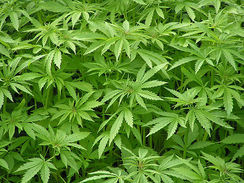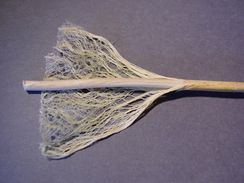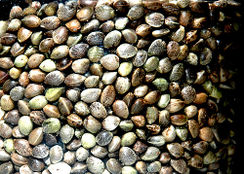Hemp: Difference between revisions
No edit summary |
No edit summary |
||
| Line 25: | Line 25: | ||
=== Cultivation === | === Cultivation === | ||
Hemp is an annual plant that grows from seed. It | Hemp is an annual plant that grows from seed. It is cultivated in a range of soils and in green houses. It can also be grown with [[Hydroponics]]. | ||
==== Beneficial conditions for cultivation ==== | ==== Beneficial conditions for cultivation in soil ==== | ||
Soil that produces high yields of corn tends to be the most suitable soil for hemp.[http://www.madehow.com/Volume-6/Industrial-Hemp.html] | Soil that produces high yields of corn tends to be the most suitable soil for hemp.[http://www.madehow.com/Volume-6/Industrial-Hemp.html] | ||
| Line 34: | Line 34: | ||
Soil temperatures must reach a minimum of 42-46°F or 5.5-7.7°C before seeds can be planted.[http://www.madehow.com/Volume-6/Industrial-Hemp.html] | Soil temperatures must reach a minimum of 42-46°F or 5.5-7.7°C before seeds can be planted.[http://www.madehow.com/Volume-6/Industrial-Hemp.html] | ||
Hemp prefers a mild climate, humid atmosphere, and a rainfall of at least 25-30 in or 64-76 cm per year.[http://www.madehow.com/Volume-6/Industrial-Hemp.html] | Hemp prefers a mild climate, humid atmosphere, and a rainfall of at least 25-30 in or 64-76 cm per year.[http://www.madehow.com/Volume-6/Industrial-Hemp.html] | ||
| Line 47: | Line 46: | ||
Fiber hemp is normally ready to harvest in 70-90 days after seeding.[http://www.madehow.com/Volume-6/Industrial-Hemp.html] | Fiber hemp is normally ready to harvest in 70-90 days after seeding.[http://www.madehow.com/Volume-6/Industrial-Hemp.html] | ||
==== | ==== Equipment for conventional harvesting ==== | ||
Combines are used for harvesting and special machines with rows of independent teeth and a chopper is used for harvesting. To harvest hemp for textiles, specialized cutting equipment is used. [http://www.madehow.com/Volume-6/Industrial-Hemp.html] | Combines are used for harvesting and special machines with rows of independent teeth and a chopper is used for harvesting. To harvest hemp for textiles, specialized cutting equipment is used. [http://www.madehow.com/Volume-6/Industrial-Hemp.html] | ||
=== | === Conventional processing === | ||
==== Retting ==== | |||
After harvest, stalks can be left exposed to the environment for four to six weeks depending on the weather. This is process is called “retting” and removes the pectin [binder]. While the stalks lay in the field, most of the nutrients extracted by the plant are returned to the soil as the leaves decompose. The stalks are turned several times using a special machine for retting evenly. | |||
==== Baling ==== | |||
After retting, stalks are baled with conventional hay harvesting equipment. | |||
==== Processing for fiber, hurd, and green micro fiber ==== | |||
A decorticator is a machine that is used to separate the hemp plant in to different materials: | |||
See main article: [[Decorticator]] | |||
Revision as of 14:29, 29 December 2019


Hemp has a variety of uses, not just for rope and fabric, but also as a readily renewable resource for making paper, construction materials, high protein food, and safe, clean fuel.
Uses
Hemp can be grown nearly anywhere. It grows very rapidly and has many uses:
- Rope. Hemp fiber is very strong.
- Textiles. Hemp fiber can be woven into a material like light cotton (suitable for T-shirts etc.) or a thick canvas material suitable for bags, warm blankets. See the page on spinning and weaving for instructions on what to do with it once harvested.
- Hempcrete (also see Wikipedia page: hempcrete)
- paper
- a small percentage of hemp was used in what appears to be a composite - rather than bioplastic - car body (70% fiber, of which fiber 10% was hemp, and 30% binder) - [1]
- replacement for plastics (example: hemp fiber, biocomposites, etc.)
- Food - The seeds are extremely nutritious.
- animal feed
- body care (soaps - from hemp oil and lye)
- various chemicals
- fuels (hemp oil / biodiesel/ cellulosic ethanol)
Cultivation, harvest, and processing
Cultivation
Hemp is an annual plant that grows from seed. It is cultivated in a range of soils and in green houses. It can also be grown with Hydroponics.
Beneficial conditions for cultivation in soil
Soil that produces high yields of corn tends to be the most suitable soil for hemp.[2]
The soil must be well drained, rich in nitrogen, and non-acidic.[3]
Soil temperatures must reach a minimum of 42-46°F or 5.5-7.7°C before seeds can be planted.[4]
Hemp prefers a mild climate, humid atmosphere, and a rainfall of at least 25-30 in or 64-76 cm per year.[5]
Harvesting
Harvest timing
The crop is ready for harvesting high quality fiber when the plants begin to shed pollen, in mid-August for North America.[6]
Harvesting for seed occurs four to six weeks later.[7]
Fiber hemp is normally ready to harvest in 70-90 days after seeding.[8]
Equipment for conventional harvesting
Combines are used for harvesting and special machines with rows of independent teeth and a chopper is used for harvesting. To harvest hemp for textiles, specialized cutting equipment is used. [9]
Conventional processing
Retting
After harvest, stalks can be left exposed to the environment for four to six weeks depending on the weather. This is process is called “retting” and removes the pectin [binder]. While the stalks lay in the field, most of the nutrients extracted by the plant are returned to the soil as the leaves decompose. The stalks are turned several times using a special machine for retting evenly.
Baling
After retting, stalks are baled with conventional hay harvesting equipment.
Processing for fiber, hurd, and green micro fiber
A decorticator is a machine that is used to separate the hemp plant in to different materials: See main article: Decorticator
Links
- Overview publication - [10]
- North American Industrial Hemp Council
- Appropedia: Hemp
- OMAFRA: Growing Industrial Hemp in Ontario
Industry Standards
- Largest hemp processing plant in America - [11]




